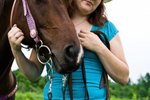Things You'll Need
Flexible measuring tape
Harness
Treats
Empty milk jugs
Sand
Dog cart
Weights
Cart pulling can be fun and entertaining for both you and your dog. But teaching your dog to pull a cart may take some patience depending on the age, size and disposition of your dog. Examine your reason for having your dog learn this task before beginning. This activity is best for the high-energy dog who needs something to do other than chew your furniture or misbehave.
Measure your dog's neck, breastbone to hind leg, shoulder to last rib, breastbone to last rib, shoulder to base of tail and finally width across hind legs. Make sure when measuring to press down against the dog's skin to avoid measuring fur.
Purchase an appropriate and well-fitting harness. The best harness will be well-padded, fit snugly, and have rings on the right and left sides if weight load is above the dog's tail. If the weight load is below the tail, the harness should have a spreader bar and a linkage below the tail and against the hind legs.
Place the harness on the dog, give him a treat and praise ("good boy") and allow him to wear the harness as long as he tolerates it. Be sure to remove the spreader bar if your harness has one. If your dog tolerates the harness. proceed to the next step. If he is having difficulty adjusting to the harness, repeat this step until he is comfortable wearing the harness. This may take several days for some dogs.
If your harness has a spreader bar, attach it now. Attach empty water jugs to the harness and place the harness on your dog. Treat and praise your dog. If your dog has trouble accepting the harness and jugs, repeat this step until the dog becomes comfortable.
Standing two to four feet in front of your dog while holding a treat, use the command "pull" and encourage the dog forward. Treat and praise him when he comes to you. Repeat this process, increasing the distance each time the dog is successful until you are confident your dog understands the command.
Add sand to the milk jugs to increase their weight. Use the "pull" command and repeat the treat and praise process from the previous step.
Detach the milk jugs and attach the cart. Repeat the treat and praise process, using the "pull" command until you are confident the dog understands the command. The cart may make more noise and may take more time for your dog to adjust to it.
Add weight to the cart. Use the command "pull" and repeat the treat and praise process.
Continue to add weight to the cart up to the weight you wish your dog to pull.
Tips
Be patient. Some dogs take more time to learn new behaviors.
Practice daily. You will lose ground if there are long lapses between training sessions.
Praise works wonders. Be sure to continually and enthusiastically praise your dog.
Do not punish your dog for mistakes. Punishment will create fear and anxiety and training will take longer.
Make sure your expectations are realistic for the size and weight of your dog.
Consult your vet before beginning training to make sure your dog is physically capable of pulling the weight you desire.
Warnings
Make sure the harness fits your dog properly and is the proper type of harness for the cart he will be pulling. A harness that is too loose or connects incorrectly to the cart can cause the weight load of the cart to shift or crash into the dog's rear end, injuring his legs.
Make sure your dog is healthy enough to pull the weight of the cart and its contents. Pulling weight may be detrimental if your dog has conditions such as hip dysplasia, osteochondrosis or heart disease.
References
Photo Credits
-
photo courtesy of American Cart & Harness http://www.K9carting.com
Writer Bio
Margaret Vogt has been writing for more than 20 years and has has been a reporter, a social worker and a mom. She holds a Bachelor of Arts in psychology and a master's degree in education. Vogt is currently working on her first children's book.




